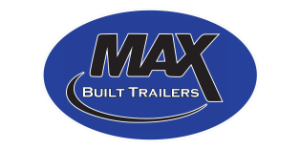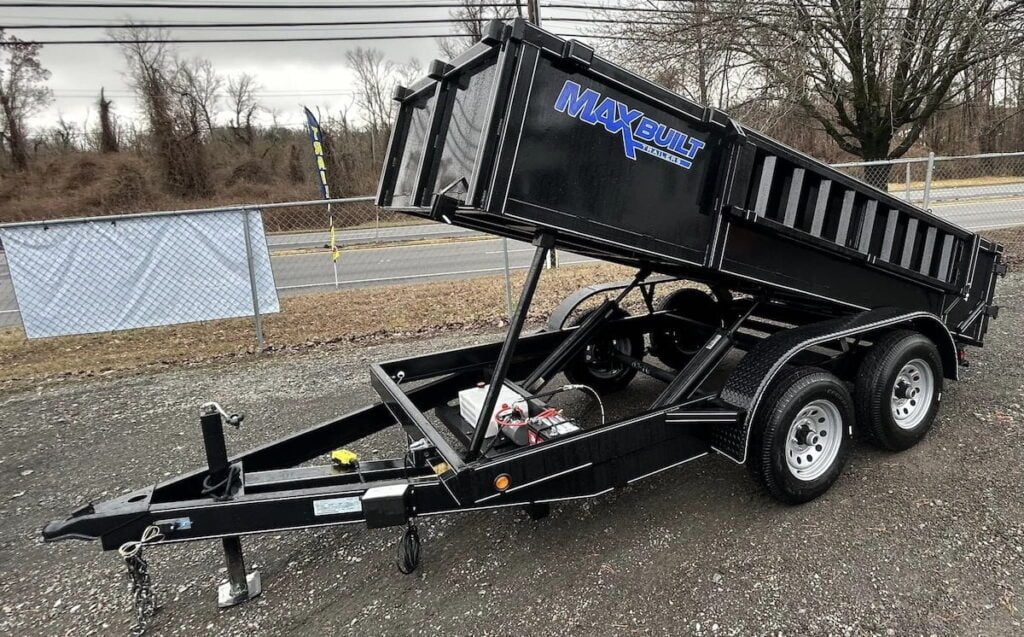The Gross Vehicle Weight Rating (GVWR) for trailers is a crucial concept that every trailer owner should comprehend to ensure safe and legal towing. GVWR represents the maximum weight a trailer can safely carry, inclusive of its own weight and the load it carries..
In this article, we’ll delve into the meaning of GVWR, its importance, and key subtopics to consider.
Defining GVWR:
GVWR is the maximum weight determined by the manufacturer that a trailer can handle, including its own weight, passengers, cargo, and fluids. Exceeding the GVWR can compromise the trailer’s structural integrity, leading to safety hazards, increased wear and tear, and potential legal issues.
Why is Gross Vehicle Weight Rating important to a customer?
Safety First: Adhering to the GVWR ensures the trailer operates within its designed capacity, promoting safe towing conditions. Overloading can strain the trailer’s components, such as tires, brakes, and suspension, increasing the risk of accidents.
Legal Compliance: Many regions have strict regulations regarding GVWR, and exceeding the specified limits can result in fines or other penalties. Understanding and adhering to these regulations is essential for responsible and legal trailer operation.
Towing Capacity: GVWR plays a pivotal role in determining a vehicle’s towing capacity. It influences the type of trailer a vehicle can tow safely and legally. Vehicle manufacturers provide guidelines on compatible trailers based on their GVWR.
How to Find the Gross Vehicle Weight Rating (GVWR) maximum for a trailer
This involves consulting the trailer itself, as the information is typically provided by the manufacturer. Here’s a step-by-step guide to help you find the GVWR maximum:
- Check the Trailer Identification Plate or Sticker:
- Locate the trailer identification plate or sticker, often affixed to the trailer frame or near the tongue.
- Look for information related to weight ratings, and specifically, the GVWR. The GVWR is usually clearly labeled.
- Review the Owner’s Manual:
- Check the owner’s manual that came with the trailer. Manufacturers often provide detailed specifications, including the GVWR, in the manual.
- Inspect the Trailer’s Data Tag:
- Some trailers have a data tag or label that provides essential information, including the GVWR. This tag is often found near the trailer’s coupler or on the frame.
- Visit the Manufacturer’s Website:
- If you can’t find the GVWR on the trailer itself, visit the official website of the trailer manufacturer.
- Look for downloadable manuals, specifications, or guides that may contain information about the GVWR.
- Contact the Manufacturer or Dealer:
- If all else fails, reach out to the manufacturer directly. Contact their customer support or technical assistance to inquire about the GVWR for your specific trailer model.
- If you purchased the trailer from a dealer, they may also assist you in obtaining this information.
- Inspect the Vehicle Identification Number (VIN):
- In some cases, the GVWR may be included in the vehicle identification number (VIN) of the trailer.
- Decode the VIN using online tools or resources specific to the trailer’s manufacturer to find relevant weight ratings.
Department of Transportation Guidelines for GVWR
The Federal Motor Carrier Safety Regulations appear in Title 49 of the United States Code of Federal Regulations, Parts 350-399 (49 CFR Parts 350-399). In section §390.5, these regulations define a commercial vehicle as one which meets any one of the following:
“Has a gross vehicle weight rating of 10,001 lbs. or more (single vehicle or total GVWR of a combination of vehicles);
Is designed or used to transport more than 8 passengers (including the driver) for compensation; or Is designed or used to transport more than 15 passengers (including the driver) and is not used to transport passengers for compensation; or
Is used to transport hazardous materials in a type and quantity requiring placards.
In addition, the Department of Public Safety (MCCD) has adopted regulations for ALL vehicles, regardless of GVWR, which meet any one of the following:
A “for-hire carrier of passengers or property (such as non-emergency medical transporters, limousines, courier services, parcel delivery services, and tow trucks);
A vehicle with a GVWR of 10,000 lbs. or less, which transports a hazardous material in a quantity that does not require placards.
The 10,001 lb. definition applies to single vehicles or combinations with a total GVWR of 10,001 lbs. or more. For example, many Ford F-350 series trucks have a GVWR that falls just below the 10,001 lb. threshold.”
North Carolina and GVWR:
There is sometimes confusion about a GVWR of 10,001 lbs. or more and if that is the minimum weight which makes a vehicle subject to the regulation.
According to the North Carolina Department of Public Safety, “vehicles with a GVWR of 10,001 lbs. or more used as part of a business (including a non-profit organization) and crosses state lines, are considered commercial motor vehicles for purposes of most of the safety regulations. This applies to single vehicles (trucks and vans) and to combinations of vehicles (such as a truck pulling a trailer or other equipment). At 26,001 lb. and above GVWR, additional requirements also apply (Commercial Driver’s License and Drug and Alcohol Testing). In addition, vehicles that carry hazardous materials and certain passenger carrying vehicles are considered commercial regardless of GVWR.”
Do you need a medical examiner’s certification for a business vehicle with a GVWR of 10,001 lbs. or more?
Yes. If the business vehicle has a GVWR of 10,001 lbs or more and crosses state lines, the medical qualifications and exam requirements will apply.
If a commercial vehicle has a GVWR of 10,001 lb. or more do you need a US DOT Number?
Yes. The identification of the power unit requires the inclusion of the company’s name and the corresponding US DOT Number. This is particularly important when crossing state lines or engaging in interstate freight transportation, including air freight. The US DOT Number is obtained from the Federal DOT in such cases. It serves as a critical identifier, ensuring compliance with regulations and facilitating proper oversight for interstate transportation activities.
Does the operator of a truck or trailer used for business with a GVWR of 10,001 lb. or more need to keep a logbook (Records of Duty Status)?
Yes. Drivers of these vehicles are subject to the hours-of-service limits and record-keeping requirements. A local driver may not need a logbook if all of the following requirements are met:
- The driver stays inside a 100-mile radius of their work-reporting location.
- The driver reports to and is dismissed from the same work reporting location each day.
- The driver works less that 12 hours each day, and drives less than 10 hours each day.
- The driver has at least 10 hours off duty between each 12-hour on-duty period. 5. Time records are kept for 6 months, showing the time in, time out, and total hours worked each day. Note: The driver is still subject to the 60 hours in 7-day rule or 70 hours in 8-day rule.
What hours-of-service limits apply for a truck with a trailer used for business that has a GVWR of 10,001 lb. or more?
- The driver may drive up to 11 hours, after having 10 consecutive hours off duty.
- The driver may not drive beyond the 14th hour after coming on duty, following 10 hours off duty.
- For a company that has vehicles operating every day, the driver may not exceed a total of 70 hours on duty time in the current 8-day period. For a company that does not operate every day, the limit is 60 hours on duty in the current 7-day period.
What is the maximum tandem axle weight allowed to be carry in North Carolina?
A tandem axle is allowed 38,000 lb. in North Carolina. Any single axle (including a steering axle) is allowed 20,000 lb.
I have a regular “First in Flight” 4,000 lb. tag on my pickup truck and occasionally I pull a utility trailer to haul my lawn mower. With the weight of my truck, trailer, and mower, exceeding 4,000 lb. would I be in violation of the weight laws?
No. With a “First in Flight” tag on a pickup truck (4,000, 5,000, and 6,000 lb tags are all “First in Flight”), North Carolina law allows a tolerance of up to 9,000 lbs. if you are pulling a trailer. **NOTE: It is the vehicle owner’s responsibility to ensure they purchase a sufficient amount of License Weight to cover the combination weight of the truck, trailer, and load.
What trucks are required to enter a North Carolina Weigh Station?
All trucks (or a truck and trailer combination) with a manufacturer’s GVWR of 10,001 lb or more are required to enter a Weigh Station in North Carolina.
Tennessee and GVWR:
Single axle maximum = 20,000 lbs.
Tandem axle = 34,000 lbs.
Gross Vehicle Weight Rating max = 80,000 lbs.
Georgia and GVWR
What is the Maximum Legal Weight Allowed?
Interstate Highway Systems
- Legal axle weight is 20,340 pounds.
- Tandem axle is any two or more axles within 96 inches.
- If gross weight is less than 73,280 pounds and length is less than 55 feet, the tandem weight is 40,680 pounds.
- If gross weight is greater than 73,280 pounds or length is greater than 55 feet, the tandem weight limit is 34,000 pounds.
What is the Federal Bridge Formula
The federal Bridge Formula is applicable on all weight limitations. Both inner and outer limitations are enforced.
The Federal Bridge Formula is:
W = 500(LN/N-1 + 12N + 36),
Where: W = Overall gross weight on any group of two or more consecutive axles to the nearest 500 pounds.
L = Distance in feet between the extreme of any group of two or more axles in group under consideration.
N = Number of axles in group under consideration.
State Route Gross Weight:
- The maximum gross weight allowed on 5 axles is 80,000 pounds.
- The maximum gross weight on 2 or 3 axles is the number of axles times 20,340 pounds.
- The maximum gross weight on 4 axles is 70,000 pounds.
Vehicles with an actual total gross weight between 73,280 pounds and 80,000 pounds, the maximum total gross weight authorized for the vehicle and load shall be determined by the State Bridge Formula.
State Bridge Formula
W = 500(LN/N-1 + 12N + 36),
Where: W = The maximum allowable gross weight of the vehicle or combination of vehicle to the nearest 500 pounds.
L = The distance in feet between the first and last axles of the vehicle or combination.
N = Number of axles on the vehicle or combination of vehicles.
- Legal axle weight limit is 20,340 pounds.
- Legal tandem weight limit on all trucks is 37,340 pounds, i.e., any two or more axles within 216 inches on the unit, not including steering axle.
- Legal tandem weight on tractor semi-trailer combinations on state highways is 40,680 pounds as provided in O.C.G.A. 32-6-26 (j).
Non-Interstate Route Exemptions
On non-interstate routes, the weight limitations may be exceeded except on posted bridges without a permit when the load on a single axle does not exceed 23,000 pounds and the maximum total gross weight does not exceed 80,000 pounds when
- Hauling forest products from the forest where cut to the owner’s place of business, plant, plantation, or residence;
- Hauling live poultry or cotton from a farm to a processing plant;
- Hauling feed from a feed mill to a farm;
- Hauling granite, either block or sawed for further processing, from the quarry to a processing plant located in the same or an adjoining county; or
- Hauling solid waste or recovered materials from points of generation to a solid waste handling facility or other processing facility;
- Hauling unhardened concrete from plant to customer.
County Road Gross Weight
The maximum gross weight allowed is 56,000 pounds unless making a pickup or delivery. If a delivery or pickup is being made evidence such as a bill of lading, shipping orders, etc. must be provided on demand.
Maximum Permit Weight Allowed
Single Trip Permits
May only be used once for movement during the times specified on permit; must include a description of the load; name of transporter; origin and destination, routes of travel and insurance provider information.
Standard Single
- Weight Limit of 150,000 lbs.
Superload Single
- Weight Limit 150,001 to 180,000 lbs.
Note: May take up to three (3) days for approval.
Superload Plus
- Weight over 180,000 lbs.
- Requires Bridge Analysis
Note: May take up to three (3) weeks for approval.
Mega Load
- Weight 300,000 lbs and above
- Requires outside Engineering
Note: Please allow at least 30 business days for GDOT’s review and coordination of the move from the date that the submittal is received from the engineering firm before a permit can be issued. Please see attached document below for a detailed explanation of the requirements.
Continuous travel allowed for loads with a gross weight of 125,000 lbs. and no dimensions except during weather conditions and holidays listed in 672-2.03(b).
Annual Permits
All annual permits must have a load specific description that matches the type of load that is being transported. This means that heavy equipment permits are only issued for drivable equipment. Non-divisible load types such as pre-stress concrete, steel trusse, concrete beams etc. will be issued their own specific type of annual permit that matches the item shown on the permit.
Are good for one (1) year from date of purchase; are interchangeable within the same company, as long as the original is in the transport vehicle at the time of movement; may be used for any load type that is not divisible, and does not exceed any dimension. Required to maintain $1 Million dollars in Automobile liability, combined single limit insurance with the Georgia Department of Public Safety as the certificate holder and must be on file with said Department for the duration of the permit.
Standard Annual
- Weight Limit-100,000 lbs.
Note: Containerized freight allowed 100,000 pounds on 5 axles.
NHS Annual
- Weight Limit-100,000 lbs.
Note: Travel on NHS routes only – see map.
Annual Commercial Wrecker Emergency Tow Permit
Effective July 1, 2013, due to the passage of HB218, Georgia will offer a new emergency tow permit replacing the old permit. Upon renewal, the new permit will be issued. Permits will be issued for 135,000 lbs. on 7 axles.
Pursuant to this code section, the commission may issue an annual permit for vehicles towing disable, damaged, abandoned or wrecked commercial vehicles, including combination vehicles, even though such wrecker or its load exceed the maximum limits specified in this article. An annual commercial wrecker emergency tow permit shall not authorize the operation of a vehicle:
- Whose single axle weight exceeds 25,000 pounds
- Whose load on one tandem axle exceeds 50,000 pounds and whose load on any secondary tandem axle exceeds 38,000 pounds; or
- Whose total load exceeds 125 feet
What are the Axle Weight Ratings (AWR)?
AWR specifies the maximum weight that each axle can bear. Understanding AWR is vital, as distributing the load evenly across the axles helps maintain stability and reduces the risk of overloading.
- Tongue Weight: The weight exerted on the hitch ball by the trailer’s tongue is crucial for proper towing balance. Proper distribution of tongue weight contributes to stable towing and prevents trailer sway.
- Payload Capacity: This refers to the maximum weight a trailer can carry, excluding its own weight. Owners must consider both payload capacity and the weight of the trailer itself when loading cargo.
- Tire Load Ratings: Tires play a critical role in supporting the trailer’s weight. Knowing the tire load ratings and ensuring they align with the GVWR helps prevent tire failure and ensures safe towing.
Conclusion:
Understanding the GVWR for trailers is fundamental for safe and legal towing. Trailer owners should familiarize themselves with GVWR, axle weight ratings, tongue weight, payload capacity, and tire load ratings to ensure a smooth and secure towing experience. By adhering to these guidelines, trailer owners can enhance safety, prolong the lifespan of their trailers, and comply with relevant regulations. Always consult the trailer manufacturer’s specifications and guidelines for accurate information tailored to your specific trailer model.
Remember to exercise caution and ensure that the GVWR is not exceeded when loading your trailer. Overloading can compromise safety and lead to mechanical issues. Always follow the guidelines and specifications provided by the manufacturer to ensure safe and legal towing. If you have any doubts or concerns, consult with professionals or experts in trailer safety.






